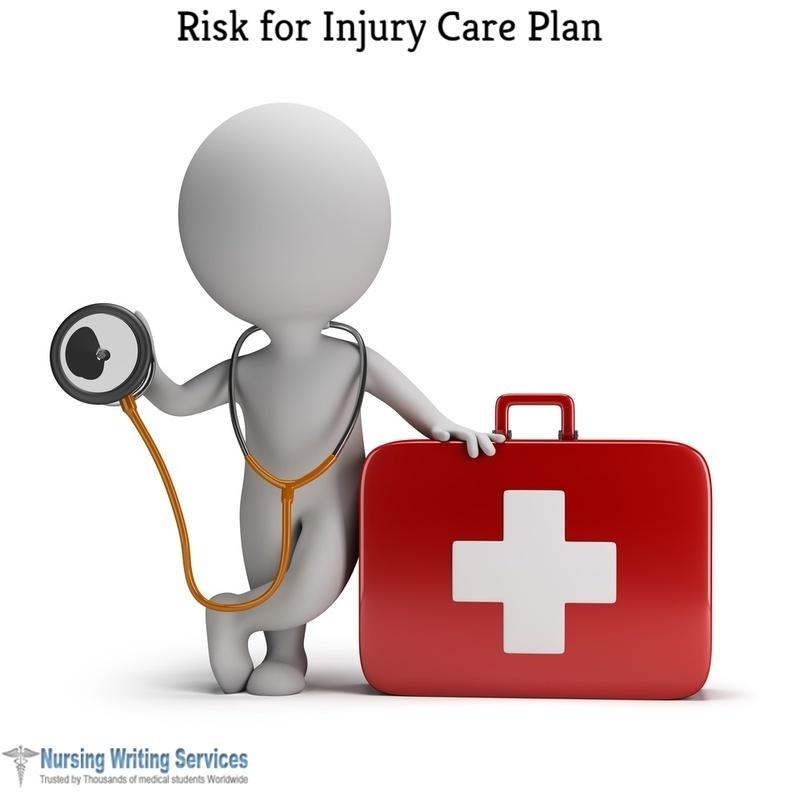
Risk for injury care plan writing services is about a vulnerability to injury due to environmental conditions interacting with adaptive and defensive resources of an individual which might compromise with health. Injuries are associated with inevitable accidents but not as a major public health problem. Medical studies, however, show that injuries follow a predictable pattern that one can prevent with the help of a caregiver.Nursing Writing Services offers the best risk for injury care plan writing services online.
Risk for Injury care plan Diagnosis
The presence of these factors increases the risk for injury:
Internal
- Abnormal blood pressure
- Dysfunction of biological and regulatory function
- Decreased hemoglobin
- Immune dysfunction
- Age psychological and physiological challenges
- Malnutrition
- Any ailments that affect the normal functioning of bodily systems
External
- Exposure to chemical pollutants
- Unfavorable physical feature, e.g., unfavorable design of a building or equipment
- Mode of transport
- Mistakes by other people attending to the patient
Risk for Injury Care Plan Goals and Outcomes
A caregiver attendant to someone with risk for injuries should have a risk for injury care plan that helps to achieve specific goals that help the patient achieve these outcomes.
- Stay free of injuries
- Identify factors that increase risks of injury
- Identify and practices preventive measures
- Increase daily activity if it is feasible
Risk for Injury Care Plan Assessment and Rationales
A detailed assessment helps to determine the likely causes for risk of injury and appropriate interventions to eliminate the risk factors contributing the frequent injuries. These assessments will help the nurse to determine the best approach to reducing the risk of injury.
Assess the patient's general status: Assessing the patient's general status helps to determine the conditions that could cause injury.
Evaluate cultural beliefs, values, and norms: A patient’s perception may contribute to the risk of injury. Some people consider it to be a cultural issue and fail to seek medical or healthcare solution.
Determine if there is exposure to community risk: Exposure to violence is a cause of depression and aggressive behavior
Assess personality style and coping capabilities: Personality style might be a cause of careless that increases the risk of injury. Mood coping capabilities by a patient helps the patient to determine the likely level of cooperation by the patient.
Check safety of home environment: A patient with a home that has clutter, improperly stored chemicals, unstable stairs, dim lighting, and high beds without rails, hazardous gas and electrical connections among other factor risk injury.
Assess patient's health status: Patients with impaired mobility, neurological dysfunction such as dementia and visual acuity are at higher risk of injury from common hazards as they impair functioning.
Risk for Injury care plan Interventions and Rationales
A care plan for risk of injury should be tailored to increase the patient’s comfort and provide ways of reducing the risk.
Thousands of students around the world get risk of injury care plan Writing Services fromNursing Writing Services. Let us write you a perfect paper!
Arrange Coordinate physical therapy sessions
A nurse should collaborate with a physical therapist to determine the best strengthening and gait training exercises that help in increasing mobility. Gait training in physical therapy helps to prevent falls. It also enhances the ability to perform ADLs.
Train the patient on safe ambulation
Teach ambulation safely including adding safety features such as bathroom handrails at a patient home. Patent’s awareness about his or her condition helps to increase safety and recovery from injury
Label significant and risk paces
Lighting an unfamiliar environment that a patient must access and labeling the places with bright colors increases visibility thus preventing the risk of fall caused injury.
Create a convenient environment for the patient
Help the patient in getting used to the layout of the surrounding environment to avoid accidents. Items that a patient uses frequently should be within easy reach. A call light or bell is also essential in enabling the patient to call for help.
Avoid extreme cold or hot items around the patient
Patients with decreased sensory deficits or reduced cognition are unable to distinguish extremes in temperature. Heating pads, hot water, etc should be away from the patient, and the use should be after confirmation of safety.
Limit wheelchair use
The use wheelchairs or Geri-chairs for patients who cannot walk should only be when the patient has to move. A caregiver should arrange and help the patient to sit on a stable chair with armrests. Patients are likely to fall when sitting on Geri or wheelchair if they forget and stand without removing the footrests or locking wheels.
Patients with decreased sensory deficits or reduced cognition are unable to distinguish extremes in temperature. Heating pads, hot water, etc should be away from the patient, and the use should be after confirmation of safety.
It is essential to collaborate with physicians for treatment of existing health condition that might be reducing alertness and increasing the risk of falls.
A caregiver should also coordinate with family members and other caregivers to arrange alternatives to restraints such as alarm systems, locking unsafe units and putting the patient on the wheeled bed unless it restraining is very necessary.
Risk for injury care plan writing services
Nursing Writing Services do not only provide high quality nursing papers written from scratch but also offer risk for injury care plan writing services. They take their time to research and come up with an original quality risk for injury care plan paper Our risk for injury care plan writing services have been rated as the best online

